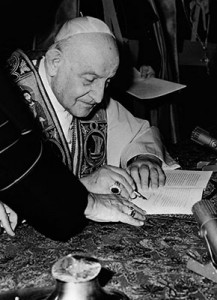Atlanta
Looking Back… April-May 1963
Published May 9, 2013

Pope John XXIII signs his encyclical “Peace on Earth” (“Pacem in Terris”) at the Vatican in this 1963 file photo. Considered a highlight in Catholic social teaching, the encyclical addresses universal rights and relations between states.
- Issues of The Georgia Bulletin in April and May 1963 are dominated by the publication of “Pacem in Terris,” the encyclical on peace of Pope John XXIII.
- The 11,000-word papal letter was issued on April 10, 1963, and the full text in English was published as a special supplement to The Georgia Bulletin of April 11, 1963. A note indicates the official text was reprinted with permission of The New York Times. The Georgia Bulletin was one of three Catholic newspapers in the United States to publish the text that week.
- The encyclical begins, “Peace on earth, which men of every era have most eagerly yearned for, can be firmly established only if the order laid down by God be dutifully observed.”
- The news story about the encyclical says it is the first encyclical addressed not only to Catholics but also to “all men of good will.” In five sections the encyclical deals with order between men; relations between individuals and public authorities in a single state; relations among states; relations of human beings and political communities with the world community; and pastoral exhortations. The encyclical also contains an unequivocal condemnation of racial discrimination.
- Additional stories relate that Pope John XXIII has made peace a theme of his entire pontificate, pleading for peace on many occasions. His work as a medical orderly and later chaplain in World War I reportedly deeply shaped his passion in seeking peace among nations. When he was in his 70s, he told an audience of his experience, saying, “The service we performed as chaplains in wartime hospitals is unforgettable. It allowed us to gather from the groans of the wounded and sick the universal aspiration for peace, the supreme good for mankind.
- It is the fourteenth encyclical of the 20th century written by various popes on the topic of peace.
- Dorothy Day, managing editor and publisher of The Catholic Worker, was among 60 women from 15 countries who presented Pope John XXIII with a request for guidance on how to translate the message of the encyclical “into lasting action” to bring peace. “How can we as women and mothers, so teach the meaning of reverence for life that it will result in a world free from the threat of war and preparation for war?” their message asked the pontiff.
- President John F. Kennedy, speaking at Boston College’s 100th anniversary, strongly praised the peace encyclical, saying that “as a Catholic I am proud of it, and as an American I have learned from it.” The president said: “In its penetrating analysis of today’s great problems of social welfare and human rights, of disarmament, international order and peace, that document surely shows that on the basis of one great faith and its tradition there can be developed counsel on public affairs that is of value to all men and women of good will.” An official statement on “Pacem in Terris” was also issued by the State Department. The statement was believed to mark the first time the U. S. government had commented on a papal encyclical.